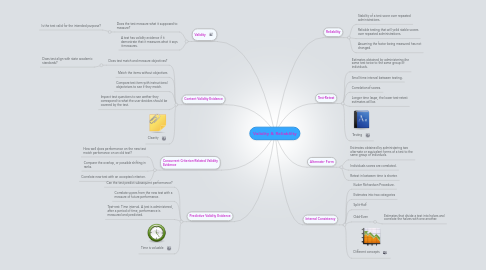Validity & Reliablilty
by Tonda Reed


1. Content Validity Evidence
1.1. Does test match and measure objectives?
1.1.1. Does test align with state academic standards?
1.2. Match the items without objectives
1.3. Compare test item with instructional objecteives to see if they match.
1.4. Inspect test questions to see wether they correspond to what the user decides should be covered by the test.
1.5. Clearity
2. Validity
2.1. Does the test measure what it supposed to measure?
2.1.1. Is the test valid for the intended purpose?
2.2. A test has validity evidence if it demostrate that it measures what it says it measures.
3. Concurrent Criterion-Related Validity Evidence
3.1. How well does performance on the new test match perfomance on an old test?
3.2. Compare the overlap, or possible shifting in ranks.
3.3. Correlate new test with an accepted criterion.
4. Predictive Validity Evidence
4.1. Can the test predict subsequent performance?
4.2. Correlate scores from the new test with a measure of future performance.
4.3. Test-rest: Time interval. A test is administered, after a period of time, performance is measured and predicted.
4.4. Time is valuable
5. Reliability
5.1. Stability of a test score over repeated administrations.
5.2. Reliable testing that will yeild stable scores over repeated administrations.
5.3. Assuming the factor being measured has not changed.
6. Test-Retest
6.1. Estimates obtained by administering the same test twice to the same group of individuals.
6.2. Small time interval between testing.
6.3. Correlationof scores.
6.4. Longer time laspe, the lower test-retest estimates will be.
6.5. Testing
7. Alternate- Form
7.1. Estimates obtained by administering two alternate or equivalent forms of a test to the same group of indivduals.
7.2. Individuals scores are correlated.
7.3. Retest in between time is shorter.
8. Internal Consistency
8.1. Kuder Richardson Procedure.
8.2. Estimates into two categories
8.3. Split-Half
8.4. Odd-Even
8.4.1. Estimates that divide a test into halves and correlate the halves with one another.
